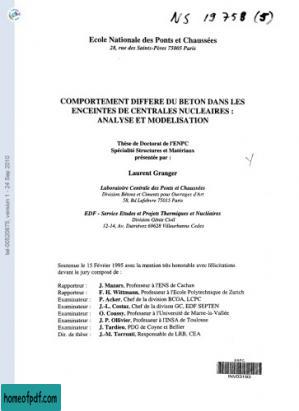上传用户: 水珊少女

The containment of French nuclear power plant of the 1300 and 1400 MWe PWR type aremade of prestressed concrete and their delayed behaviour is systematically monitored by avery complete instrumentation. In an accidental phase, the tightness of the 1.2 m thickstructure, dimensioned to withstand an internal absolute pressure of 0.5 MPa depends mainlyon the residual prestress of concrete. But surveillance devices reveal substantial differencesfrom one site to another, from which the regulation calculation models cannot makesatisfactory allowance.For the purpose of improving the management of the population of power stations, EDF in1992 initiated a large study aimed at predicting the true creep behaviour of the containmentsalready built. This study, more material oriented, includes numerous shrinkage and creep testson reconstructed concrete in laboratory as well as on cement paste and aggregate. The mainresults are presented in part one.In the second part, we consider the different delayed strains of concrete one by one. A preciseanalysis of the physico-chemical phenomena at the origin of the delayed behaviours, leads usto propose a practical modelling of concrete in an overall equivalent continuous materialapproach. Secondly, the few parameters of the model are determined on the experimentalresults. In order to do so, two particular finite element programs in CESAR-LCPC have beendeveloped. The first one permits to take into account the non linear diffusion of humidity inconcrete as a function of temperature. The diffusion coefficient D(C) (C = water content) isfitted on the loss of weight tests as a function of time. The second step is a creep calculation ;7first, the program reads back the temperature and humidity results of the previouscomputations and then calculates the different delayed strains in time. For basic creep, wehave chosen a viscoelastic model function of temperature and humidity. The numericalscheme uses the principle of decomposition of the compliance function in Dirichlet series asproposed by Bazant. Thus, it is possible to calculate the shrinkage and creep functions, underconstant biaxial stress field (taking into account the initial prestressing of concrete), of onenuclear containment element modelled as a 1.2 m thick ring.The last phase consists in realising, knowing the creep and shrinkage behaviour of theparticular structure, a coupled calculation in order to account for the stress redistribution thattakes place between the prestressing cables and the concrete. Indeed, the delayed strains ofconcrete will cause the stress in concrete to drop slightly in time. In order to do so, we realisea non ageing calculation by using the Carson transformed.Finally, in the third part, we present the results of our simulations. We conclude by giving theprincipal theoretical and practical lessons of this study.

